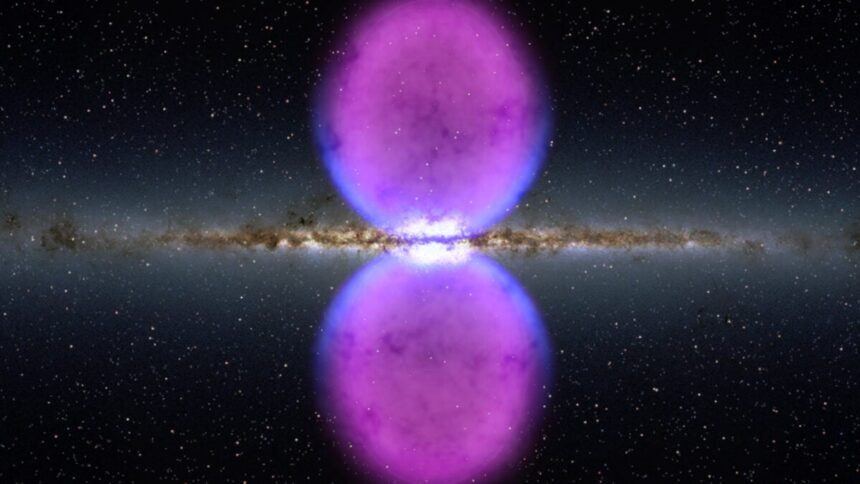In the center of our galaxy, gigantic, balloon-like structures of high-energy radiation extend thousands of light-years above and below the Milky Way’s plane. Known as the Fermi bubbles, the massive lobes may have been the result of a violent outburst in our galaxy’s recent past. A new discovery of cold hydrogen clouds embedded inside the bubbles adds another level of mystery to the objects, suggesting they’re only a few million years old—practically brand-new, by cosmic standards.
Using the National Science Foundation’s Green Bank Telescope in West Virginia, a team of scientists discovered something extremely odd. Lurking inside the hot Fermi bubbles are clouds of cold gas that shouldn’t be there, forcing scientists to wonder how the cooler gas manages to survive in the superheated, extreme environment. The new findings, published in The Astrophysical Journal Letters, shed light on how galaxies evolve over time.
The Fermi bubbles were discovered in 2010 by NASA’s Fermi Gamma-ray Space Telescope. The two orbs form an hourglass structure, one stretching above and another below the center of the Milky Way. Each lobe is around 25,000 light-years tall, made up of gamma rays and high-energy cosmic rays.
“Fermi bubbles are a relatively recent discovery – they were first identified by telescopes that ‘see’ gamma rays in 2010 – there are different theories about how it happened, but we do know that it was an extremely sudden and violent event, like a volcanic eruption but on a massive scale,” Rongmon Bordoloi, associate professor of physics at North Carolina State University and co-author of the research, said in a statement.
The team behind the study was observing the Fermi bubbles to gather high-resolution data about the composition of the hot gas within the structure. The majority of gas inside the Fermi bubbles is super-hot, measuring at around 1 million degrees Kelvin. Surprisingly, the team also found clouds of neutral hydrogen gas dotted within the bubbles around 12,000 light-years above the center of the galaxy and as massive as several thousand Suns.
The gas in the clouds, however, is relatively cold compared to the rest of the gas in the bubbles. “They’re around 10,000 degrees Kelvin, so cooler than their surroundings by at least a factor of 100,” Andrew Fox, astronomer at the Space Telescope Science Institute and coauthor of the paper, said in a statement. “Finding those clouds within the Fermi bubble is like finding ice cubes in a volcano.”
Considering their extreme environment, the clouds of hydrogen should have been destroyed, a process that would take over a few million years. This means that the Fermi bubbles are much younger than expected. “It wouldn’t be possible for the clouds to be present at all if the Fermi bubbles were 10 million years old or older,” Bordoloi said.
The scientists behind the study believe that the clouds were swept up from the center of the Milky Way and carried by the hot wind that formed the Fermi bubbles. Jay Lockman, an astronomer at the Green Bank Observatory and coauthor of the paper, compared the system to a more familiar phenomenon: “Just as you can’t see the motion of the wind on Earth unless there are clouds to track it, we can’t see the hot wind from the Milky Way but can detect radio emission from the cold clouds it carries along.”
Read the full article here












